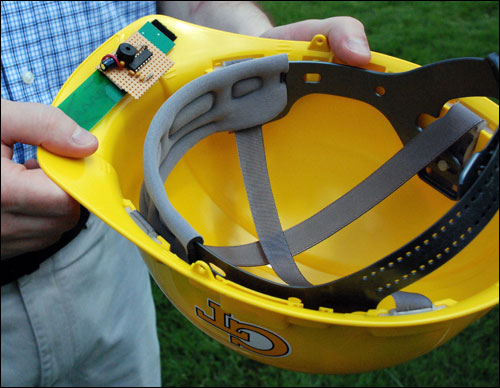A team of researchers at the Georgia Institute of Technology’s Real-time Automated Project Information and Decision Systems (RAPIDS) laboratory and Duke University have completed testing of an energy-harvesting radio frequency identification system that, when tags are attached to hard hats, can issue an alert in the event that heavy equipment is moving too close to a worker on a construction site. The solution is unique, in that the tag can operate from power stored on a built-in capacitor, enabling the tag to be smaller than it would have been if it had a battery, while also ensuring that the system does not fail due to batteries requiring replacement.
The technology was developed through funding from the National Science Foundation and the Construction Industry Institute, and was then tested multiple times over the past three years, at several large industrial construction sites throughout the Southeast. Approximately two weeks ago, the most recent test was completed by the Georgia Department of Transportation, regarding road-construction equipment.
The system, known as Self-Monitoring Alert and Reporting Technology for Hazard Avoidance and Training (SmartHat), was developed under the leadership of Jochen Teizer, an assistant professor at Georgia Tech’s School of Civil and Environmental Engineering, as well as Matt Reynolds, a Nortel Networks assistant professor of electrical and computer engineering at Duke University. In recent weeks, the team finished testing the system with tags on static equipment, as well as with actual workers wearing hard hats, in the presence of RFID readers attached to heavy equipment.
The ultrahigh-frequency (UHF) reader, designed with off-the-shelf components, is placed within a vehicle and wired to an antenna on top of an equipment cabin, or at the rear of the vehicle.
Improving safety on construction or manufacturing sites has been the project’s focus, Teizer says, noting that the group hoped to develop a non-active tag that would eliminate the need for batteries. However, he adds, the researchers did test a battery-assisted passive (BAP) UHF transponder, which provided a longer read range than the capacitor-assisted passive SmartHat tag. According to Teizer, active tags not only are vulnerable to inoperability if batteries die, but can also be expensive—as much as $500 apiece.
The capacitor-assisted passive tag solution can achieve a read range of up to 16 meters (52 feet), Teizer says, while BAP tags can work reliably at a distance of 18 meters (59 feet) or more, with typical operating ranges of 35 meters (115 feet). The group’s prototype capacitor-assisted passive tag measures about 5 centimeters (2 inches) square.Researchers attached both types of tags—capacitor-assisted and BAP—to hard hats on static equipment, as well as to those worn by workers. Heavy machinery—such as dump trucks, excavators, rollers and wheel loaders—were then outfitted with a device known as an Equipment Protection Unit, which included an RFID reader, batteries, an antenna for receiving tag transmissions, and a data logger to store information from each read. When the interrogator came within read range of a worker’s RFID tag, the tag’s built-in rectifier converted incoming UHF signals to the direct current (DC) required to power an audible alarm on the helmet tag.
All chip-based passive RFID tags contain a rectifier; however, Reynolds says, the SmartHat tag is unique, in that it contains a microprocessor and an alarm speaker optimized for this specific application. During testing, the tag transmitted a signal encoded with a unique ID number, and when the reader received that signal and determined that it belonged to a tag assigned to a worker, it warned the equipment operator (via an audible alarm) that a person was in the vicinity. With the rectifier, tags can accumulate and store 10 seconds’ worth of operating power, to deliver an alert in the event that the reader’s signal is interrupted. The system was also tested with BAP tags, in order to determine whether the read range could be lengthened. In both cases, UHF EPC Gen 2 tags were employed, which were designed by the researchers (including the inlays and chips).
When the reader detected a tag’s unique ID, it stored that number, as well as the time and date at which that tag was read. That information could be uploaded to a PC at the end of the day by the construction site’s management, and could then be analyzed to determine which personnel came within range of hazardous equipment, and how often. This would enable management to determine if the construction worksite layout should be modified, Teizer explains, or if certain workers or equipment operators required additional training.
The researchers are also designing a similar system for use in ascertaining if an employee enters a hazardous zone where he or she should not be present. The team has been developing software that could be used in combination with Building Information Modeling (BIM) created at job sites, to set up zones into which specific staff members should not venture. An RFID reader would be installed at a stationary location at the zone, and if the device detected an unauthorized tag ID, an alarm could be sounded in the area, while an alert could also be issued to safety or security management, via a wired or wireless Internet connection, or as historical data saved on the reader’s data logger. Such a system has been tested in the laboratory environment, Teizer says, and the research team also plans to test it on live construction sites.
The group now hopes to partner with an RFID technology and software developer to make the system commercially available. Teizer predicts that tags would cost less than $5 apiece once sold in large numbers, or embedded directly into helmets. Construction safety, security, material tracking and other applications that require tracking identification and the issuing of warnings or alerts would benefit from the technology, he says, noting that the initial investment-benefit analysis conducted by the researchers promises high rates of return.
According to Teizer, the prototype tag and reader for this solution, built with RFID components modified by the researchers, may need to be designed more specifically for the application, in order to improve the read range. “However,” he states, “for many of the harsh construction applications, the technology is very promising.”



